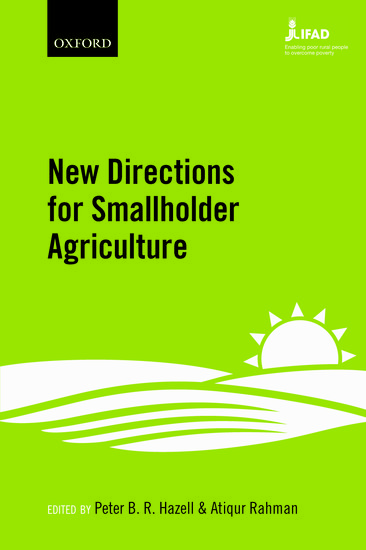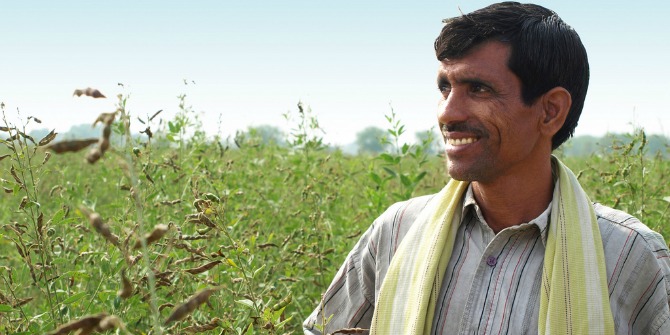This book aims to examine the growing divergence between subsistence and business oriented small farms, and discusses how this divergence has been impacted by population growth, trends in farm size distribution, urbanization, off-farm income diversification, and the globalization of agricultural value chains. Chandni Singh finds that the strength of this book is that it consolidates recent research on the state of smallholder farmers and provides an unbiased report on future strategies that should be supported because of their proven relevance and success. For readers looking to understand recent transitions in smallholder farming, the book reflects on how drivers such as population growth, market integration, livelihood diversification, and national and global policies are affecting smallholder farmers.

New Directions for Smallholder Agriculture. Peter Hazell and Atiqur Rahman. Oxford University Press. March 2014.
It is estimated that more than 2 billion people depend on smallholder agriculture for their livelihood. Characterised by asset constraints (material and institutional), low yields, and labour-intensive farming techniques, smallholders are often criticised for their nonviable scale of operation and inability to compete in a fast globalising economy. On the other hand, smallholders are also seen as key contributors to world food security (Wiggins and Keats, 2013; Godfray et al., 2010) and natural resource management. Recent experiences also show that some smallholders are successfully diversifying their livelihoods and building agricultural enterprises.
New Directions for Smallholder Agriculture attempts to negotiate the space between these two camps: one that believes smallholder farming is economically nonviable and that investment in large farms that are better integrated with global markets is the way to food security; and the second that maintains that smallholder farmers play a crucial role as agents of developmental and social change. In doing so, it provides a case for viewing smallholder farms as resilient units that, if invested in, can contribute to meeting current development challenges and negotiating future climate-related uncertainties.
The book is a collection of 16 papers, all part of a conference organised by International Fund for Agricultural Development (IFAD) in 2010. It is edited by Peter Hazell (former Director of development strategy and governance at IFPRI) and Atiqur Rahman (former Lead Strategist and Senior Policy Coordinator at IFAD), both experts in international development and agriculture in developing countries. The book is divided into three parts, each with chapters discussing broad continental trends across Asia, Africa, and Latin America and finer scale stories from exhibiting various contexts. The first part reviews different approaches used to define smallholder farmers and the current limitations they face.
Sir Gordon Conway, Professor of International Development at Imperial College, London, opens the book with an evocative illustration of Mrs. Namarunda, a fictitious smallholder in Africa (Chapter 2), whose story he uses to illustrate the complex challenges smallholders face and the innovative strategies they undertake to negotiate the social, economic, environmental, and institutional landscape in which they are embedded. Acknowledging scholarly disagreement around definitions of smallholder farmers, Conway identifies three widely accepted facts about smallholder agriculture as it stands today. First, that land division followed by population rise is causing landholding size to decrease. Second, smallholders are increasingly facing land and water deterioration with climate change poised to exacerbate current conditions. Third, smallholder farmers remain key contributors to social development and the rural economy in developing countries. He goes on to tackle the dilemma at the centre of the smallholder issue – since returns on labour are insufficient to pull farmers out of poverty, should smallholder farming – although ecologically and economically sustainable – be supported or even encouraged? Conway argues that while larger farms do offer economies of scale and better returns on labour, there are several examples of large scale cultivation in Africa failing spectacularly from the 1940’s Groundnut Scheme in Tanzania to vegetable cultivation for export in Senegal. He makes a case against polarised discussions around food security that focus on ‘either/or’ options (e.g. small vs. large farms or GM vs. organic cultivation) and calls for a move towards ‘both/and’ discussions that create a space for large and small farmers, thereby bringing the strengths of each to contribute to global food security efforts.

Part two of the book explores the constraints and opportunities available for helping small farms to be run as businesses. In “Promoting small farmer market access in Asia: issues, experiences, and mechanisms” (Chapter 7), Sukhpal Singh examines several case study to demonstrate how different actors can facilitate better market access and integration. He looks at state-farmer partnerships (e.g. vegetable cooperatives like Safal in India) to NGO-farmer linkages (e.g. Bangladesh Rural Advancement Commission, which introduces new crops and systems to smallholders and helps build links with supermarkets). Singh also quotes examples from private sector intermediaries (e.g. green onion packers in China engage smallholders by providing seed and pesticides) and public-private partnerships (e.g. NGO BASIX and Pepsico who facilitate potato production in Jharkhand, India). He concludes that just as the contexts and priorities of smallholders are diverse, so are the modes available for forming successful market links.
The papers in the final section highlight socioeconomic and policy constraints in securing smallholder livelihoods, especially in the face of uncertain land tenure (Chapter 14), climate change (Chapter 16), and competing non-farm livelihoods (Chapter 17). Of special mention is Chapter 11, “A twenty-first-century balancing act: smallholder farm technology and cost-effective research” by John Lynam and Stephen Twomlow, both agricultural experts with experience of working with key international R&D organisations. They reflect on how successes in irrigated agriculture are difficult to replicate in rain-fed farming because of the heterogeneity and system complexity encountered in the latter. They note that while the emphasis on adaptive research (characterised by being iterative, often participatory, and more demand-driven) has increased, agricultural R&D organisations are still unable to balance cost effective research while ensuring that technologies developed do not face adoption roadblocks. Going a step further, Lynam and Twomlow demonstrate through examples (such as the CGIAR overhauling its research programmes to ensure organisational linkages and avoid repetitive research) that to make R&D for smallholder agriculture effective, creative research is not enough. The authors call for a systematic focus on addressing organisational and institutional challenges.
The strength of the book is that it consolidates recent research on the state of smallholder farmers and provides an unbiased report on future strategies that should be supported because of their proven relevance and success. For readers looking to understand recent transitions in smallholder farming, the book reflects on how drivers such as population growth (and subsequent decreases in landholdings), market integration, livelihood diversification (especially into non-farm enterprises), and national and global policies are affecting smallholder farmers. However, I feel the book could have been made crisper and more accessible for the lay reader or time-pressed development practitioner and policymaker by avoiding repetition (for example, the constant quoting of global statistics of farmers in chapters).
In recognition of the contributions that smallholder farmers make to food security, rural livelihoods, and development, 2014 has been declared as the International Year of Farming. Given the present challenges smallholders face, and the future risks posed by climate change, the relevance of New Directions for Smallholder Agriculture cannot be emphasised enough. For those interested in agricultural research and development, the book is a welcome addition to the growing call for action to strengthen smallholder farmer livelihoods.
————————————-
Chandni Singh recently completed her PhD in Rural Livelihoods from the University of Reading where her research explored farmer vulnerability to water scarcity and climate change in Rajasthan, India. She has worked with indigenous communities in the Himalayas towards climate change adaptation and watershed development and her research interests include rural transformations and natural resource management. Chandni blogs at Village Vignettes and tweets @_chandnisingh. Read more reviews by Chandni.








1 Comments